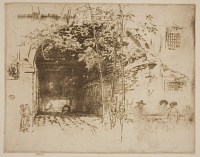Etchings Institutions search term: keppel
The Traghetto, No. 2 | ||
| Number: | 233 | |
| Date: | 1880 | |
| Medium: | etching and drypoint | |
| Size: | 243 x 307 mm | |
| Signed: | butterfly at lower left (1-3); replaced with a butterfly further up (4-final) | |
| Inscribed: | no | |
| Set/Publication: | 'First Venice Set', 1880 | |
| No. of States: | 9 | |
| Known impressions: | 60 | |
| Catalogues: | K.191; M.188; W.156 | |
| Impressions taken from this plate (60) | ||
KEYWORD
TITLE
'The Traghetto' (1880, FAS). 1
'The Traghetto' (1886, Frederick Wedmore (1844-1921)). 2
'The Traghetto' (1887/1888, Whistler). 3
'The Traghetto. No. 2' (1909, Howard Mansfield (1849-1938)). 4
'The Traghetto, No. 2' (1910, Edward Guthrie Kennedy (1849-1932)). 5
The original title is 'The Traghetto' although this inevitably causes confusion with the earlier version of the subject, Traghetto [231]. Thus ' The Traghetto, No. 2 ' is the preferred title.
1: GUW #12267.
2: Wedmore 1886 A (cat. no. 156).
3: List, [1887/1888], GUW #13233.
4: Mansfield 1909 (cat. no. 188).
5: Kennedy 1910 (cat. no. 191).
DESCRIPTION
SITE
6: Grieve 2000 , pp. 83–84.
DISCUSSION
7: Pennell 1908 , vol. I, pp. 280, 281.
8: ibid, pp. 280, 281.

